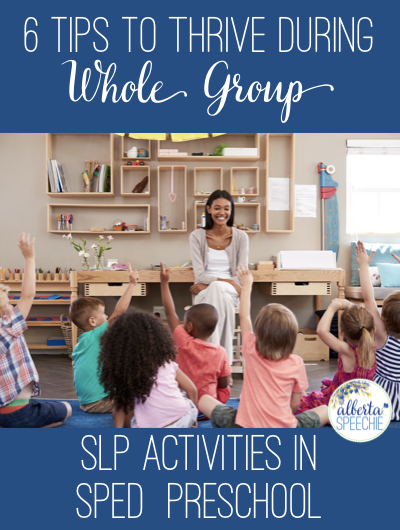Whole group activities can be very intimating especially in a preschool setting. You have to keep the activities engaging, but not so appealing that you have difficulty maintaining order and the children learning. If the children are not interested, then chaos can ensue. That being said, whole activities are a great way to target many goals at once. To have an excellent whole group activity, you need to plan, plan, plan. Click here for a form that I use to plan. Here are six tips to help have fun and effective circle activities:
1. Keep activities short. Preschoolers have short attention spans. Make sure that every activity or step has a purpose. The longer an activity goes on, the odds are you are going to have to spend more time on behaviour management. That is no fun for anyone.
2. Keep the activities simple. In my experience, the fewer steps that preschoolers or staff have to do, the more success the activity will be. The activity will move quickly. The children will understand and be able to complete the activity more independently.
3. Have a plan on how to manage the group. Are they going to take turns? How are the children going to take their turns? This is where knowing your group will come in handy. Will the size of your group allow for children to take individual turns? How are you going to handle the child(ren) who just has to go first? How are you going to decide the order of children’s turns? I tend to choose the order of children. The children who are able to complete the activity more independently tend to be first. The children who benefit from lots of models went later in the order.
If you are not giving turns, but they are going to do an activity all at once, what will that look like? In the past, I have had children shout out answers, do actions altogether or stand up if they agree with my statement (e.g., “My favourite pet is a dog.”) I have also used two choice cards that the children hold up to answer my questions or respond to my statements. These choice cards are an excellent way for non-verbal/low verbal children to also participate in activities.
4. Use visuals! If you have read any of my other posts, you will know how much I love visuals. What visuals will you need for the activity? These are usually tied to the concept/skills you are targeting in the activity or activities. For example, I will have a picture of a boy, a girl, and a group of children when working on he, she, and they. Make sure they are large enough that everyone in the group can easily see them. If you have a child with vision difficulties, then give that child his/her own visuals and ensure they are adapted to his/her needs. If you don’t have time to make “pretty” visuals, then quickly draw them out. Drawn visuals are waaaay more effective than no visuals at all.
5. Adapt the activity so everyone can participate. Odds are many children in your group will need the activity changed in some way in order to participate. If a child is using some form of AAC, is that word or words available for them to use? Is this activity above the language skill of a child/group of children? Do any of your children have physical concerns that may make so that it is difficult to do that activity as is? If you have a child with anxiety, what are you going to do if they are unable to participate independently? These are some questions that I try to answer when planning an activity.
6. Have fun! The more you are enthusiastic in an activity, the more the children will be interested and engaged. Modulate your voice. Be silly. Exaggerate your body movements. It allows children to attend to an activity longer and be more excited to learn. At the beginning of my career, this was way out of my comfort zone, but the more I did it, the more comfortable I became.
Whole group activities are lots of fun to do, and they are most successful when they are well thought out. Also know this, that not every whole group activity will be successful. Don’t be afraid to end an activity early and I usually have a plan B activity in my back pocket. Reflect on what went well and what you need to change.
Whole group activities are lots of fun to do, and they are most successful when they are well thought out. Also know this, that not every whole group activity will be successful. Don’t be afraid to end an activity early and I usually have a plan B activity in my back pocket. Reflect on what went well and what you need to change.

